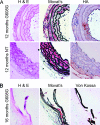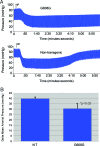Progressive vascular smooth muscle cell defects in a mouse model of Hutchinson-Gilford progeria syndrome
- PMID: 16492728
- PMCID: PMC1413943
- DOI: 10.1073/pnas.0600012103
Progressive vascular smooth muscle cell defects in a mouse model of Hutchinson-Gilford progeria syndrome
Abstract
Children with Hutchinson-Gilford progeria syndrome (HGPS) suffer from dramatic acceleration of some symptoms associated with normal aging, most notably cardiovascular disease that eventually leads to death from myocardial infarction and/or stroke usually in their second decade of life. For the vast majority of cases, a de novo point mutation in the lamin A (LMNA) gene is the cause of HGPS. This missense mutation creates a cryptic splice donor site that produces a mutant lamin A protein, termed "progerin," which carries a 50-aa deletion near its C terminus. We have created a mouse model for progeria by generating transgenics carrying a human bacterial artificial chromosome that harbors the common HGPS mutation. These mice develop progressive loss of vascular smooth muscle cells in the medial layer of large arteries, in a pattern very similar to that seen in children with HGPS. This mouse model should prove valuable for testing experimental therapies for this devastating disorder and for exploring cardiovascular disease in general.
Conflict of interest statement
Conflict of interest statement: No conflicts declared.
Figures





References
-
- DeBusk F. L. J. Pediatr. (Berlin) 1972;80:697–724. - PubMed
-
- Baker P. B., Baba N., Boesel C. P. Arch. Pathol. Lab. Med. 1981;105:384–386. - PubMed
-
- Stehbens W. E., Wakefield S. J., Gilbert-Barness E., Olson R. E., Ackerman J. Cardiovasc. Pathol. 1999;8:29–39. - PubMed
-
- Stehbens W. E., Delahunt B., Shozawa T., Gilbert-Barness E. Cardiovasc. Pathol. 2001;10:133–136. - PubMed
-
- Ackerman J., Gilbert-Barness E. Pediatr. Pathol. Mol. Med. 2002;21:1–13. - PubMed
Publication types
MeSH terms
Substances
Grants and funding
LinkOut - more resources
Full Text Sources
Other Literature Sources
Molecular Biology Databases
Research Materials
Miscellaneous

